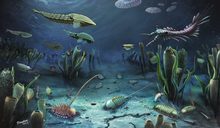Cordaticaris
| Cordaticaris Temporal range:
| |
|---|---|

| |
| Diagram of the head sclerites of C. striatus | |

| |
| Life restoration of C. striatus (the trunk region is speculative, being based on a close relative, Cambroraster). | |
| Scientific classification | |
| Domain: | Eukaryota |
| Kingdom: | Animalia |
| Phylum: | Arthropoda |
| Class: | †Dinocaridida |
| Order: | †Radiodonta |
| Family: | †Hurdiidae |
| Genus: | †Cordaticaris Sun, 2020 |
| Type species | |
| Cordaticaris striatus Sun, 2020
| |
Cordaticaris
Hurdiids like Cordaticaris were the most diverse lineage of radiodonts, both in terms of geographic distribution, and ecological roles. They are differentiated from other radiodont groups by their large head sclerites, their tetraradial mouth-parts, and their appendages bearing around five subequal endites.[2] The diversity of hurdiid head sclerites is notable, with some genera like Aegirocassis and Hurdia possessing long, pointed sclerites.[3][4] While others like Cambroraster and Titanokorys possessed horseshoe-shaped sclerites.[5][6]
Description
Classification
The features present in Cordaticaris (cephalic carapace, elongated endites, and the oral cone shape) align it with the hurdiids.[1] In 2022 when describing new remains of the basal hurdiid Stanleycaris, Moysiuk and Caron assigned Cordaticaris to a derived position within the hurdiid family alongside Cambroraster and Titanokorys.[7]
| Phylogentic position of Cordaticaris in relation to other radiodonts |
| Phylogenetic position of Cordaticaris after Moysiuk & Caron 2022.[8] |
Paleoecology

Cordaticaris fossils are known from a site called the Linyi Lagerstätte, which sits above the Panchegou Member within the larger Zhangxia Formation. The site is known for its soft bodied preservation, with some of the arthropod taxa known showing preserved digestive systems. According to the 2022 paper that analyzed the site, there are "35 fossil taxa, including four
Notes
References
- ^ S2CID 224868404.
- ^ Pates S, Lerosey-Aubril R, Daley AC, Kier C, Bonino E, Ortega-Hernández J. 2021. The diverse radiodont fauna from the Marjum Formation of Utah, USA (Cambrian: Drumian) PeerJ 9:e10509 https://doi.org/10.7717/peerj.10509
- ^ Van Roy, Peter (12 March 2015). "Fossils of huge plankton-eating sea creature shine light on early arthropod evolution". The Conversation. Retrieved 16 March 2015.
- S2CID 86465719.
- PMID 31362637.
- PMID 34527273.
- S2CID 250361698.
- S2CID 250361698.
- ^ PMID 35832778. Retrieved 2 April 2023.
